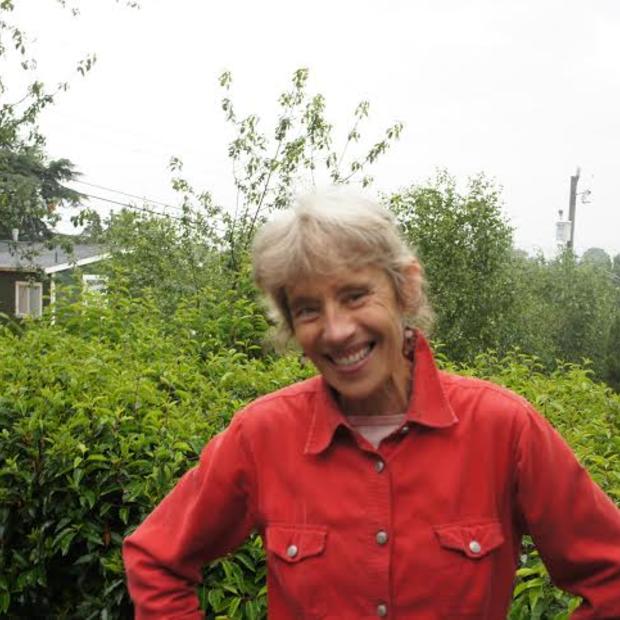Alex Sawyer, with Solarize Washington, points to a color-coded solar resource map of the U.S. and a map of a European country in the corner. Washington state is dark blue, Southern California and New Mexico dark red. The big question, Sawyer explains to the rapt audience at a community center, is does solar work in gray Western Washington?
Click on the player above or here to listen to the audio version of this story.
The answer is yes. Germany, she says, is also color-coded dark blue. They have 15 percent less annual sun than the Puget Sound.
“But they've bested us by far in how much solar they've been able to install with that resource. The reason for that is not because Germany is the sunniest place in the world. It's because Germany has great incentives.” Solar has become accessible she says, it’s the norm. “As such, awareness has really skyrocketed about solar as an option."
Solarize Washington is partnering with community groups to spread the word about solar and build critical mass to capitalize on group discounts. The goal is to make solar more accessible here. “There's a couple of benefits we see about the way we run our program," Sawyer says. "One is the trust factor. People are generally overwhelmed with being sold things and this is much less of a sales program and more of a community education program with an end goal of installing solar."
A pilot began two years ago with the community group, Sustainable Queen Anne. Two more Seattle campaigns followed, then a partnership with the Snohomish PUD. From now through April, Solarize Washington is holding workshops for Northwest Seattle residents. Partial funding is from Seattle City Light. Workshops are scheduled in Ballard, Bitter Lake and Wallingford. They’re being held in these areas for one reason: community involvement.
About a year ago, Bill Thorness with Sustainable Ballard contacted Solarize Washington and began to compile the names of people interested in installing solar. "We started to build that list and it eventually grew to about 200 people before we entered the bid to get the program to bring it to our neighborhood." Once Solarize Washington is assured there’s enough community interest, they’ll hold a free workshop including site assessments and group discounts from solar contractors.
Incentives include a 30 percent federal tax credit, a state sales tax exemption if a solar system is purchased by June 30th and an annual production incentive capped at five thousand a year through June 2020. This incentive is credited by a utility when solar panels generate more energy than a home needs. Another incentive offers homeowners fifteen cents per kilowatt hour for solar systems made out of state and fifty-four cents per kilowatt hour for those made in-state.
“That incentive is really designed to build a local solar industry here because folks receive a much bigger payback on their system if they buy it here," Sawyer explains. With incentives, she says, a solar system made in-state can be paid off in eight years.
To date the critical mass/ community approach has added 138 solar systems to the regional grid and invested 3.8 million in the local economy. The only hitch — Solarize Washington, a non-profit program of Northwest SEED, Sustainable Energy for Economic Development — can only offer the discount program in neighborhoods with active community groups.
Jennifer Maury attended the Northwest Seattle workshop. “I live on Beacon Hill and as such don't qualify for the program, which is a total rip-off," she complained. Sawyer encouraged her to organize a community group in her own neighborhood and, in the meantime, to approach solar installers at the workshop to see if she can cash in on another neighborhood's group bid.
The primary stumbling block to solar gaining traction is upfront costs, which range from fifteen to thirty thousand dollars. Twenty-two states have already brought down costs through 3rd party financing. A solar company receives federal tax credits for leasing solar systems to homeowners. The only requirement is that the home owner purchase the solar energy, which would be offered at a price comparable to hydro, for a period of time.
House Bill 1106, introduced during the 2013 legislative session, would legalize 3rd party financing in Washington. Rob Kreihbel, with Environment Washington, is optimistic about its chances. “It's my hope that when this happens it's going to significantly expand our solar market so that people in the middle-income and lower-income ranges can take advantage of it." The organization has a goal of 150,000 solar roofs by 2020.
But another bill introduced this session has those committed to expanding solar concerned. HB 1301, introduced by Representative Jeff Morris, would amend the definition of “community solar” to largely eliminate incentives for solar projects on public property. The non-profit Backbone Campaign on Vashon Island, which was approved for a community solar project by the King County Council in October 2012, sent an alert asking supporters to weigh in on the bill. Their hope: That the legislature will accept the existing definition of community solar and defend incentives for public benefit.
The low cost of hydropower has also been a hurdle. But Solarize Washington is upbeat. They say the cost of solar may soon be competitive with hydro. A nationwide Department of Energy program, the Rooftop Solar Challenge, has funded twenty-two teams across the nation to lower the soft costs of installing solar. The Washington contingent, the Evergreen State Solar Project, is a partnership between utilities, counties and cities — including Bellevue, Edmonds, Ellensburg and Seattle.
Coupled with advances in lowering the cost of modules and components, analysts believe solar will be cost competitive, even in gray Western Washington, in less than ten years.



